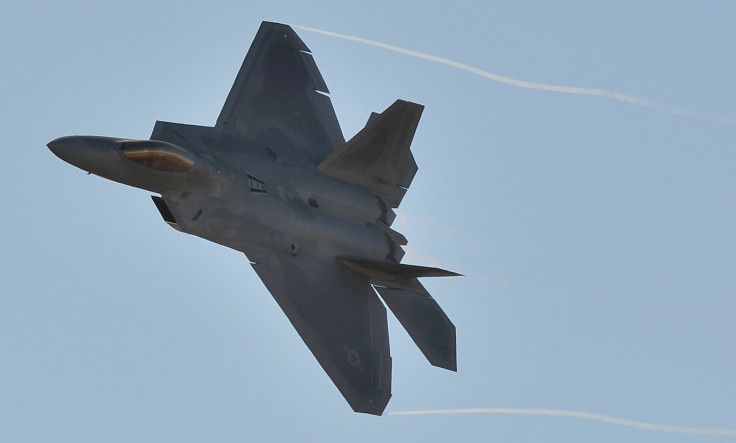Airstrikes Against ISIS, Khorasan In Syria See Combat Debut Of F-22 Raptor After 9 Years

The airstrikes on Monday against ISIS and Khorasan targets inside Syria marked the combat debut of the F-22 Raptor, the $400 million stealth fighter that had never before fired a shot in anger in nine years of front-line service. After a spate of technical problems that led to a grounding of the fleet and pilot discontent, critics had panned the jet, made by Lockheed Martin, as an expensive failure. The Raptor had sat out the Afghanistan, Iraq and Libya air wars before finding its first operational use in Syria.
The radar-evading jets were used on Monday to hit ground targets with highly precise guided bombs, a role that is not the Raptor’s primary intended function. Designed to sneak undetected past radar and missile air defenses, the Raptors were conceived at the end of the Cold War to kill Soviet planes deep into their airspace -- but then adapted to a new role as U.S. conflicts changed.
“F-22s hit ground targets, (including) an ISIS command and control center in Raqqa, with GPS-guided munitions,” Gen.William Mayville, Joint Staff director of operations, said at a Pentagon briefing on Tuesday.
Syria is arguably the country with the best anti-aircraft defenses among those the U.S. and its allies have fought in the past 15 years. Bashar al-Assad’s regime may even be fielding Russian S-300 missiles, among the most sophisticated anti-aircraft weapons today; Assad said last year the first shipment had been delivered. The F-22 is the only airplane in the U.S. inventory other than the B-2 stealth bomber able to evade detection by air defense radars, without which missiles are blind.
Yet those air defenses were quiet on Monday night, as waves of American and allied aircraft entered Syrian airspace. “Target acquisition by Syria was passive,” Mayville said. “It’s fair to say that last night was passive radar.” Translated from aviation jargon, it means that Syrian radars were tracking the airplanes and knew where they were, but did not lock onto them as a means to guide missiles.
The U.S. and Syria did not, however, coordinate the airstrikes. “We did not coordinate our actions with the Syrian government. We did not provide advance notification to the Syrians at a mililtary level, or give any indication of our timing on specific targets,” U.S. State Department spokeswoman Jen Psaki said in a statement.
Still, Psaki said, U.S. Ambassador to the United Nations Samantha Power had informed the Syrian mission at the U.N. of the intention to hit terrorists inside Syria. It’s possible that the Syrians decided not to attack coalition warplanes, knowing that they were not after regime targets.
But entering a heavily defended, unfriendly airspace is still a risky endeavor, one the F-22 is well suited to. “All of the best gear is going into this fight because we have to treat it like a very high-threat environment," ABC News consultant Col. Stephen Ganyard said.
The Raptors were part of the second of three waves of attacks by U.S. and coalition aircraft, missiles and drones, Mayville said. This second wave included “F-22s, F-15s, F-16s, B-1 bombers and drones from bases in the region” and was launched at around 9 p.m. Eastern time Monday night, hitting barracks and vehicles as well, the general said.
The first wave consisted of Tomahawk missiles launched at 8:30 p.m. from the destroyer USS Arleigh Burke and the cruiser USS Philippine Sea, in the Red Sea and Persian Gulf. The missiles hit “targets in and near Aleppo and Raqqa. Khorasan group compounds comprised the majority of those strikes,” Mayville said.
The third and final wave “came shortly after midnight” and included F-18 jets from the USS George Bush aircraft carrier in the Persian Gulf, as well as aircraft from other bases in the region, Mayville said. The targets were “ISIS training compounds and combat vehicles.” Coalition partners flew in the second and third waves, providing combat air patrols -- using fighter jets to cover bombers from any air attack – and “actual strikes on the majority of targets in the third wave.”
The partners were Saudi Arabia, the United Arab Emirates and Jordan, while Qatar provided a supporting role, said Rear Admiral John Kirby, the Pentagon’s press secretary.
© Copyright IBTimes 2024. All rights reserved.






















